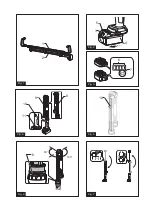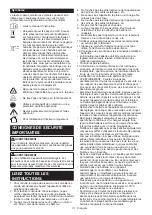
5 English
Symbols
The following show the symbols which may be used
for the equipment. Be sure that you understand their
meaning before use.
• Read instruction manual.
Ni-MH
Li-ion
• Only for EU countries Due to the presence
of hazardous components in the equipment,
waste electrical and electronic equipment,
accumulators and batteries may have a
negative impact on the environment and
human health. Do not dispose of electrical
and electronic appliances or batteries
with household waste! In accordance
with the European Directive on waste
electrical and electronic equipment and
on accumulators and batteries and waste
accumulators and batteries, as well as their
adaptation to national law, waste electrical
equipment, batteries and accumulators
should be stored separately and delivered
to a separate collection point for municipal
waste, operating in accordance with the
regulations on environmental protection.
This is indicated by the symbol of the
crossed-out wheeled bin placed on the
equipment.
• Optical Radiation (UV and IR).
Minimize exposure to eyes or skin.
• Do not stare at operating lamp.
• Use appropriate shielding or eyes protection.
• Take particular care and attention!
• For indoor use only
IMPORTANT SAFETY
INSTRUCTIONS
WARNING:
To reduce the risk of injury, do not stare at operating
appliances. Serious eye injury could occur.
CAUTION:
When using appliances, basic safety precautions
should always be followed to reduce the risk of fire,
electric shock, and personal injury, including the
following:
READ ALL INSTRUCTIONS.
1. To reduce the risk of injury, close supervision is
necessary when the appliance is used near children.
2. To reduce the risk of electrical shock, do not put the
appliance in water or other liquid. Do not place or
store the appliance where it can fall or be pulled into
a tub or sink.
3. Do not cover the appliance with cloth or carton, etc.
Otherwise it may cause a flame.
4. Do not touch the inside of the appliance with
tweezers, metal tools, etc.
5. Do not expose the appliance to rain or snow. Do not
wash it in water.
6. Do not touch the inside of the appliance with
tweezers, metal tools, etc.
7. Do not contact hot parts.
8. When the appliance is not in use, always switch off
and remove the battery cartridge from the appliance.
9. Do not give the appliance a shock by dropping,
striking, etc.
10. Only use attachments recommended or sold by the
manufacturer.
11. Store product indoors when not in use. Keep out of
reach of children.
12. Safety information for portable luminaires with
batteries.
• Battery disposal should be in compliance with
your local regulations that address the disposal of
hazardous materials.
• Do not incinerate the battery.
13. Additional information for luminaires.
• The light source of this luminaire is not replaceable;
when the light source reaches its end of life the whole
luminaire shall be replaced.
14. Battery tool use and care.
• WARNING: Read all safety warnings and instructions.
Failure to follow the warnings and instructions may
result in electric shock, fire and/or serious injury.
• Prevent unintentional starting. Ensure the switch is
in the off-position before connecting to battery pack,
picking up or carrying the appliance. Carrying the
appliance with your finger on the switch or energizing
appliance that have the switch on invites accidents.
• Disconnect the battery pack from the appliance before
making any adjustments, changing accessories, or
storing appliance. Such preventive safety measures
reduce the risk of starting the appliance accidentally.
• Recharge only with the charger specified by the
manufacturer. A charger that is suitable for one type of
battery pack may create a risk of fire when used with
another battery pack.
• Use appliances only with specifically designated
battery packs. Use of any other battery packs may
create a risk of injury and fire.
• When battery pack is not in use, keep it away from
other metal objects, like paper clips, coins, keys, nails,
screws or other small metal objects, that can make a
connection from one terminal to another. Shorting the
battery terminals together may cause burns or a fire.
• Under abusive conditions, liquid may be ejected from
the battery; avoid contact. If contact accidentally
occurs, flush with water. If liquid contacts eyes,
additionally seek medical help. Liquid ejected from the
battery may cause irritation or burns.
• Do not use a battery pack or appliance that is
damaged or modified. Damaged or modified batteries
may exhibit unpredictable behavior resulting in fire,
explosion or risk of injury.
• Do not expose a battery pack or appliance to fire
or excessive temperature. Exposure to fire or
temperature above 130 °C (265 °F) may cause
explosion.
• Follow all charging instructions and do not charge the
battery pack or appliance outside of the temperature
range specified in the instructions. Charging
improperly or at temperatures outside of the specified
range may damage the battery and increase the risk
of fire.
• Have servicing performed by a qualified repair person
using only identical replacement parts. This will ensure
that the safety of the product is maintained.
Содержание DML818
Страница 2: ...12 1 2 3 4 5 6 7 8 9 11 10 180 90 13 Fig 1 Fig 4 Fig 6 Fig 7 Fig 5 Fig 2 Fig 3...
Страница 3: ...21 22 21 22 19 20 18 14 15 16 16 17 23 23 Fig 10 Fig 12 Fig 13 Fig 11 Fig 8 Fig 9...
Страница 45: ...45 Ni MH Li ion UV IR 1 2 3 4 5 6 7 8 9 10 11 12 13 14...
Страница 46: ...46 130 C 265 F 15 1 2 3 50 C 122 F Makita Makita Makita Makita 16 10 C 40 C 50 F 104 F Fig 2...
Страница 48: ...48 Fig 9 Fig 10 Fig 11 Fig 12 Fig 13 LED Makita Makita Makita Makita Makita...
Страница 80: ...80 Ni MH Li ion 1 2 3 4 5 6 7 8 9 10 11 12 13 14 130 C 265 F...
Страница 81: ...81 15 1 2 3 50 C 122 F c Makita Makita Makita 16 10 40 C 50 104 F Fig 2...
Страница 83: ...83 Fig 10 Fig 11 Fig 12 Fig 13 Makita Makita Makita Makita Makita...
Страница 105: ...105 Ni MH Li ion 1 2 3 4 5 6 7 8 9 10 11 12 13 14 130 C 265 F...
Страница 106: ...106 15 1 2 3 50 C 122 F Makita Makita Makita Makita Makita 16 10 C 40 C 50 F 104 F Fig 2...
Страница 107: ...107 Fig 3 75 100 50 75 25 50 0 25 1 2 3 Makita Fig 4 1 2 Fig 5 fig 4 Fig 6 Fig 7 45 90 180 0 180 Fig 8...
Страница 108: ...108 Fig 9 Fig 10 Fig 11 Fig 12 Fig 13 Makita Makita Makita Makita Makita...
Страница 125: ...125 Ni MH Li ion UV IR 1 2 3 4 5 6 7 8 9 10 11 12 13 14 130 C 265 F...
Страница 126: ...126 15 1 2 3 50 C 122 F Makita Makita Makita Makita Makita 16 10 C 40 C 50 F 104 F Fig 2...
Страница 127: ...127 Fig 3 75 100 50 75 25 50 0 25 1 2 3 Makita Fig 4 1 2 Fig 5 fig 4 Fig 6 Fig 7 45 90 180 0 180...
Страница 128: ...128 Fig 8 Fig 9 Fig 10 Fig 11 Fig 12 Fig 13 Makita Makita Makita Makita Makita...
Страница 135: ...135 Ni MH Li ion UV IR 1 2 3 4 5 6 7 8 9 10 11 12 13 14 130 C 265 F...
Страница 136: ...136 15 1 2 3 50 C 122 F Makita Makita Makita Makita Makita 16 10 C 40 C 50 F 104 F Fig 2...
Страница 138: ...138 Fig 9 Fig 10 Fig 11 Fig 12 Fig 13 LED Makita Makita Makita Makita Makita...
Страница 140: ...140 Ni MH Li ion 1 2 3 4 5 6 7 8 9 10 11 12 13 14 130 C 265 F...
Страница 141: ...141 15 1 2 3 50 C 122 F 16 10 C 40 C 50 F 104 F Fig 2...
Страница 143: ...143 Fig 10 Fig 11 Fig 12 Fig 13 LED...
Страница 150: ...150 Ni MH Li ion UV IR 1 2 3 4 5 6 7 8 9 10 11 12 13 14 130 C 265 F...
Страница 151: ...151 15 1 2 3 50 C 122 F Makita Makita Makita Makita Makita 16 10 C 40 C 50 F 104 F Fig 2...






































